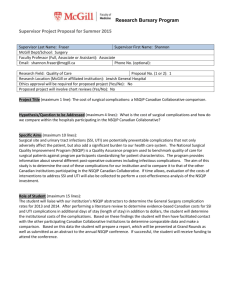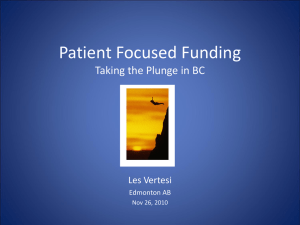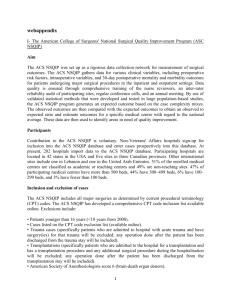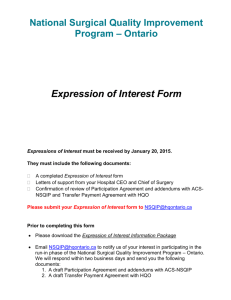American College of Surgeons
advertisement
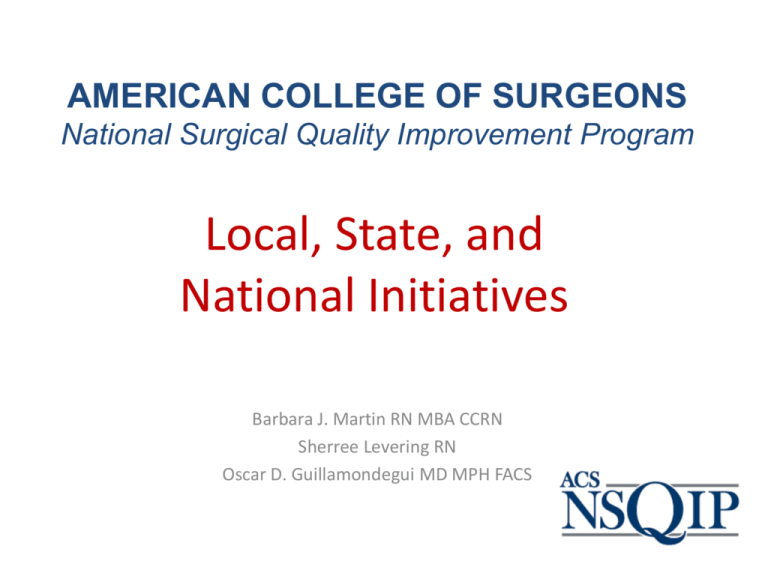
AMERICAN COLLEGE OF SURGEONS National Surgical Quality Improvement Program Local, State, and National Initiatives Barbara J. Martin RN MBA CCRN Sherree Levering RN Oscar D. Guillamondegui MD MPH FACS National Surgical Quality Improvement Program • • Objective: Describe components of National Surgical Quality Improvement Program (NSQIP) In order to receive full contact-hour credit for the CNE activity, you must – Be present no later than five (5) minutes after starting time – Remain until the scheduled ending time – Complete /submit Evaluation form before leaving at the conclusion • • • Conflict of Interest: None Commercial Support: None. Non-Endorsement of Products: None – Accredited status does not imply endorsement by Vanderbilt Medical Center, TNA or ANCC of any products that might be displayed in conjunction with this program. • • Off-label Product Use: N/A Accreditation Statement – Vanderbilt University Medical Center, Department of Nursing Education and Professional Development is an approved provider of continuing nursing education by the Tennessee Nurses Association, an accredited approver by the American Nurses Credentialing Center’s Commission on Accreditation. • 1.0 Contact Hour National Surgical Quality Improvement Program • Initially developed by the VA to risk-adjust outcomes in response to public concerns • American College of Surgeons expanded the program to the private sector in 2004 • Currently 408 hospitals enrolled – Community / Private / Academic – Half have fewer than 500 beds; program is expanding options to include smaller facilities ACS NSQIP • • • • Validated, clinically-based data collection Collects and analyzes clinical outcomes data Measures quality of systems of care Quantifies 30-day risk-adjusted surgical outcomes, including morbidities and mortality • Blinded comparison with national performance • Currently working with CMS to develop outcomes measures for surgical procedures We Give NSQIP . . . • 40 cases every 8 days (minimum 1680 / year) – Random sampling General and Vascular Surgery – Targeted procedure selection: 100% capture • Colectomy • Proctectomy • Ventral Hernia Repair – Inpatient and outpatient procedures • Selected by service and CPT code • Age > 17 • Trauma / Transplant excluded during that admission Data Collection • Manual chart review and abstraction • Strict definition of abstracted elements • 150 variables – Demographics, preoperative factors and labs • Medical and surgical history • Acute and chronic clinical risk factors – Intraoperative events – Postoperative occurrences, discharge data • Infectious complications—surgical site, urinary, pneumonia • Technical occurrences—graft failure, bleeding • Other events—reintubation, renal failure, cardiac arrest Preoperative Risk Factors • • • • • • • • BMI Smoking Diabetes CHF Exacerbation Ascites COPD Weight loss Functional Status • • • • • • • • Surgery within 30 days Open wounds Sepsis / Septic shock Impaired Sensorium Acute Renal Failure Dialysis Preoperative Steroids Blood transfusions Postoperative Occurrences • Infectious complications: Surgical Site Infection, UTI, Sepsis • Respiratory Occurrences: Pneumonia, Unplanned Intubation, On vent > 48 hours • Cardiac Occurrences: MI, cardiac arrest • Renal Failure • Stroke • Peripheral nerve injury Abstraction Requirements • All patients are followed for 30 days after surgery • Surveillance definitions are not the same as clinical definitions • The abstractor’s clinical judgment is valuable, but not always assignable • All elements of the definitions must be met for preop risk and postop occurrence – Do the findings meet the purpose of the definition? – Do they meet the letter of the definition? A Note about Clinical Abstraction Elements may be consistently “findable”. . . Or not . . . SIRS, Sepsis, Septic Shock • Systemic Inflammatory Response Syndrome: presence of two or more of the following: – – – – – Temp >38 C or < 36 C HR > 90 bpm RR >20 /min or PaCO2 <32 mmHg WBC >12,000 , <4000, >10% bands Anion gap acidosis • Sepsis – Two of the above AND purulence or positive culture • Septic Shock – All the above AND evidence of organ dysfunction SIRS? Sepsis? Septic Shock? • 72 year old male presents to the ED in distress with severe chest / epigastric / flank pain • VS T 36.4 BP 118/74 HR 110 RR 24 • PMH Coronary artery disease, insulin dependent diabetes mellitus, chronic pyelonephritis • Loses consciousness BP 80/40 HR 116 • Taken to CT scan Septic Shock? Shock? Yes Septic? NO 30 Day Follow Up • Many patients are seen in clinic at 30+ days • Minor operations (appendectomy, hernia repair) may not be seen after two weeks. • If no documentation in StarPanel, patients are contacted via telephone. No less than three attempts are made. • Vanderbilt’s fully integrated medical record improves follow-up rates on pateints with and without postoperative occurrences. NSQIP Gives Us . . . • Risk-adjusted surgical morbidity and mortality • Semiannual Observed /Expected Ratio reports • Interim reports: ongoing monitoring, comparison with internal and external peer groups • Internal data analysis: access to institutional data for report development, integration with other data sets Semiannual Report • Reports 12 months of data, with risk adjusted outcomes • 39 Risk Adjustment Models – Mortality – Overall Morbidity – Cardiac Occurrences – Respiratory Occurrences – Surgical Site Infection – Colon surgery LOS • Observed / Expected Ratios for each model Mortality and Morbidity O/E Ratios • Observed / Expected Outcomes – An O/E of 1 indicates the outcomes were the same as expected • Less than 1 indicates better than expected • Greater than 1 indicates worse than expected – High outliers have confidence intervals greater than 1 – Low outliers have confidence intervals less than 1 Sample Hospital O/E Report High outlier Low outlier Risk Factors determine the “Expected” Case Number Mort Probability 004377 0.2352% 004378 1.0114% 004379 53.8254% 004380 12.7381% 004381 0.0477% 004382 3.7919% 004383 0.0975% Occurrences determine the “Observed” Occurrences by Inpatient vs Post D/C 100.0% Pre-discharge 90.0% Prior to discharge 80.0% 70.0% 60.0% 50.0% 40.0% 30.0% 20.0% 10.0% 0.0% 196 10 19 41 45 77 92 SSI PULMONARY EMBOLISM DVT REQUIRING THERAPY URINARY TRACT INFECTION UNPLANNED INTUBATION PNEUMONIA ON VENTILATOR > 48 HOURS Semiannual Report Statistics July 2011 •January 1 – December 31, 2010 • 258 hospitals • ~375,000 cases •Vanderbilt: 1,560 cases •1,393 General surgery cases •168 Colon and rectal surgery (all services) •167 Vascular surgery cases Cases by Service Vascular Hepatobiliary 4% 11% Onc/Endo 26% CRS 14% EGS 22% GI / Lap 23% Procedure Distribution 160 140 120 100 80 60 40 20 0 Risk Adjustment Models Mortality Morbidity SSI • Functional Status • CPT Risk CPT Risk • ASA Class • ASA Class BMI • CPT Risk • SIRS / Sepsis / Shock Inpatient Status • Age • Inpatient / Outpatient Wound Class • SIRS / Sepsis / Shock • Functional Status Current Smoker • Disseminated Cancer • Preop Albumin ASA Class • SGOT > 40 • Surgical Specialty Bilirumin > 1 • Albumin • COPD Steroid Use • Emergency • BMI Work RVU • Creatinine > 1.2 • Creatinine Transfer Status • Platelets < 150 • Vent dependence Surgical Specialty Data Analysis Hepatobiliary 5% CRS 13% Onc/Endo 27% Vascular 13% EGS 17% GI / Lap 25% VUMC Initiatives • VPEC – Assessment and documentation of risk elements including smoking history, functional status • Bariatric Surgery – Early foley discontinuation – Incentive spirometry education and postop monitoring • Vascular Surgery – Pulmonary assessment pre / postop • Emergency General Surgery – Documentation of emergent status Current VUMC Initiatives • Colorectal surgery – Clinical analysis of NHSN-identified infections with NSQIP variables – Evaluation of NHSN / NSQIP case selection variation • Vascular Surgery analysis of postop respiratory failure and pneumonia • ICU Database multicenter project • NSQIP PARS analysis: evaluating correlation between clinical outcomes and provider complaints NSQIP, NHSN, and Administrative Data • NHSN – SSI surveillance based on ICD-9, otherwise very little difference – HAI surveillance primarily inpatient • Device associated infections initially monitored in the critical care setting • Currently monitoring CLABSI in general care; CAUTI soon • Administrative data (UHC) – Based on provider documentation, coding data’s primary purpose initally was reimbursement. – Only the index hospitalization is captured. • NSQIP – Like NHSN, abstraction is from clinical documentation, based on strict definitions – Follows all patients for 30 days—inpatient, outpatient, discharged – No device associated infection designation NSQIP Participants 400 + Hospitals About half are academic UHC 369 hospitals 114 academic / 255 affiliates Risk Adjustment Clinical risk factors as documented in medical record APR-DRG based on coding, other administrative data Outcomes (Mortality) 30 days post-op Inpatient hospitalization Service designation Surgical service for included procedure Discharge / Major Service Inclusion By procedure Inpatient / Outpatient All hospital discharges by attending service Inpatient only (Outpatient data is now being submitted) Comparison data Blinded risk-adjusted data Comparison with peer hospitals Tennessee Surgical Quality Collaborative Tennessee Chapter of American College of Surgeons Tennessee Hospitals Blue Cross Blue Shield of Tennessee Tennessee Center for Patient Safety (THA) Tennessee Surgical Quality Collaborative • A consortium of surgeons and hospitals committed to evaluate and improve surgical care by surgeons in the state of Tennessee • 10 member hospitals with active engagement of surgeon champions, nurse reviewers, and administrators. – – – – Learn from high performers Develop best-practice recommendations Identify system variables influencing clinical performance Non-competitive environment for shared learning TSQC Mission and Vision Mission • To improve the care of the surgical patient by supporting an open discussion and transfer of information through a collaborative team effort. Vision • To identify best surgical practices, examine how the surgical team obtains best outcomes and teach other surgical teams how to improve outcomes. TSQC Development 2007 Partnership model proposed to Blue Cross 2008 3 year grant awarded to TSQC 2009 Hospitals enrolled, training and abstraction in progress April 2011 AHA NPSF Fellowship January 2011 Draft Action Plan for Statewide Initiatives July 2010 First O/E September 2011 Grant Renewal application submitted October 2011 Eleven additional hospitals submit applications 21 TSQC Hospitals? Grant Overview • 3 year grant May 2008- May 2011 • Initial grant to support of 8 hospitals; BCBS increased funding to support 10 hospitals / surgeon champions • THA’s TN Center for Patient Safety serves as coordinating center for the collaborative • Initial grant period extended to October 2011; renewal application has been submitted Pre-Op Risk Factors* Comparative Data Analysis Diabetes: Insulin Non-Insulin Dialysis Smoked in last yr COPD Functional Status Dependent Hypertension *Not actual data VUMC TSQC NSQIP 9.8% 14.5% 2.6% 25.3% 5.6% 9.3% 15.4% 2.8% 28.5% 8.0% 5.4% 7.6% 1.9% 20.6% 4.9% 4.4% 57.3% 3.5% 60.2% 1.9% 46.4% 30 Day Mortality and Post – Op Occurrences* Comparing Tennessee Outcomes to National Performance ONLY CONFIRMED 30-DAY FOLLOW-UP CASES TSQC NSQIP 10,635 211,930 Total Number of Cases Outcome Cases Alive at 30 Days Cases Dead Within 30 Days 10,433 191 98.2% 1.8% 208,243 3,687 98.2% 1.8% Superficial SSI 240 2.3% 5,206 2.5% Deep SSI 52 0.50% 833 0.4% Organ Space SSI 219 2.1% 5,414 2.6% Wound Disruption 31 0.3% 1,458 0.7% Pneumonia 198 1.9% 5,206 2.5% Urinary Tract Infection 209 2.0% 7,289 3.5% Severe Sepsis 94 0.9% 2,499 1.2% Postop Occurrences Mean # of Occurrences *Not actual data 0.2 (+ 0.7) 0.2 (+ 0.7) TSQC Members Comparison 12 10 SSI Pneumonia Mortality 8 6 4 2 0 Hospital Hospital Hospital Hospital Hospital Hospital Hospital Hospital Hospital Hospital A B C D E F G H I J *Not actual data Key Successes: 2009 -2010 • Acute Renal Failure – – Collaborative-wide improvement – Seven of 10 sites showed improvement; one site significantly improved • Graft/Prosthesis Flap Failure – Collaborative-wide improvement – Eight sites improved; one significantly. • On Ventilator > 48 hours – Collaborative-wide improvement • Superficial Incisional SSI – Collaborative-wide improvement – Thirteen procedure groups improved while hernia repair showed significant improvement. – Seven sites improved; one significantly • Wound Disruption – Collaborative-wide improvement. – Eight sites improved; two significantly. • Financial Model Shows Positive Results TSQC Opportunities • Surgical Site Infections As the First Focus – Colorectal surgery bundle – Evaluation and implementation in 10 hospitals • Rationale: – High Volume occurrence in TSQC data – 9 of 10 SCNRs identified SSI as opportunity – Aligns with hospital current focus on SSI via CMS SCIP public reporting – Business case – Length of Stay and Costs significant TSQC Member Hospitals NSQIP Hospitals TSQC Member Hospitals NSQIP Hospitals Future NSQIP hospitals? NSQIP and the Nation • The Centers for Medicare and Medicaid Services (CMS) is considering five measures from ACS NSQIP for national implementation • NSQIP – based programs – Bariatric Surgery Center Network – NSQIP-Pediatric – Trauma Quality Improvement Program • ACS Goal: 1000 member hospitals by 2012 NSQIP Innovations • 2011 Additional Options – Small and Rural: hospitals with < 1680 cases / year – Essentials: smaller data set – Procedure Targeted: 100% of specific cases – Classic: allows additional variables for research • Florida Surgical Care Initiative • 2012 Updates – Procedure targeted variables Special thanks to Sherree Levering Oscar Guillamondegui Naji Abumrad Chris Clarke Senior VP Tennessee Hospital Association Joe Cofer Erlanger Medical Center TSQC Leadership Committee and Membership TN Chapter American College of Surgeons Blue Cross - Blue Shield of Tennessee Tennessee Hospital Association / Tennessee Center for Patient Safety
